If you’re a proud owner of a cockatiel, male cockatiels included, you know how important it is to take good care of them. One crucial aspect of caring for your feathered friend, whether it’s an adult bird or a budgie, is determining their age. Knowing your cockatiel’s age can help you provide appropriate care and understand their behavior better, just like with any other parrot.
So, how can you tell the age of your adult cockatiel, a bird species related to the budgie and parrot? The answer lies in observing physical characteristics such as their eyes, beak, and feathers. Older cockatiels may have cloudy or discolored eyes, longer and thicker beaks, and more worn feathers.
However, determining the age of a male cockatiel isn’t just about physical appearance. It’s also essential to consider their history and previous care when estimating their age accurately. One way to determine the age of a male cockatiel is by looking at their tail feathers. Younger birds will have shorter tail feathers than older ones. Another indicator is the presence of pin feathers, which are new feathers that are still growing. Additionally, comparing a male cockatiel’s size to that of a budgie can provide some insight into their age.
Consulting with a veterinarian or experienced breeder can provide more accurate information about your bird’s age. In this article, we’ll explore some tips on how to tell the age of your cockatiel, budgie, or baby bird and why it matters for their well-being. So let’s dive in! Whether you have had your feathered friend for a year or just a few days, understanding their age can help you provide the best care possible.
| Age Indicator | Description |
|---|---|
| 1. Bare Skin around the Eyes | Young birds have less pronounced bare skin patches around their eyes. |
| 2. Crest Development | Young birds have smaller, less-defined crests that mature over time. |
| 3. Feather Patterning | Feather colors and patterns become more vibrant and distinct as they age. |
| 4. Tail Feathers | Young cockatiels have shorter, stubbier tail feathers than older birds. |
| 5. Sexual Maturity | Cockatiels reach sexual maturity at 18-24 months; breeding behavior indicates an adult. |
| 6. Eyes | Eye color can lighten with age, with young birds having darker eyes. |
| 7. Beak Color | A young cockatiel’s beak may be slightly darker, lightening as it matures. |
| 8. Activity Level | Older birds tend to be calmer and less hyperactive than younger ones. |
| 9. Vocalization | Young birds may have softer or less varied vocalizations compared to adults. |
| 10. Molt Patterns | Young cockatiels may undergo more frequent molts than older birds. |
| 11. Leg Scale Color | The color of leg scales can change with age, becoming paler over time. |
| 12. Eye Rings | Young cockatiels often have less distinct or colorful eye rings. |
Ways to Determine the Age of a Cockatiel: Exploring Age Tracking and Behavioral Aspects
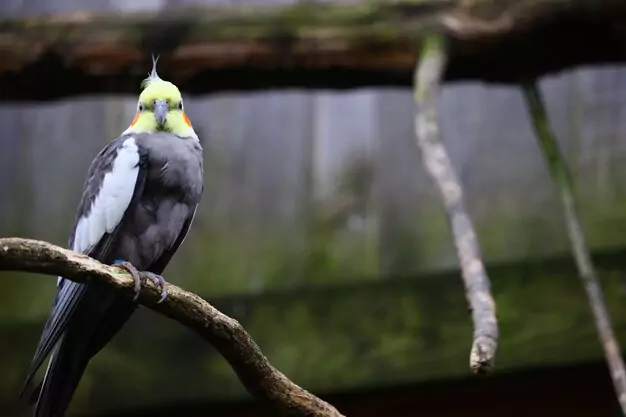
Cockatiels and budgies are fascinating birds that make excellent pets due to their affectionate nature, intelligence, and playful behavior. However, determining the age of a baby cockatiel or budgie can be challenging, especially if you don’t have any prior experience with these birds. In this article, we will explore different ways to determine the age of a cockatiel or budgie by tracking changes in behavior and physical appearance over days, weeks, months, and even up to a year.
Life Expectancy Varies Among Cockatiels Due to Several Factors
Before we discuss how to determine the age of a baby cockatiel, it’s essential to understand that life expectancy varies among these birds due to several factors. In general, cockatiels live for 15-20 years in captivity, but some may live longer or shorter depending on their genetic makeup, diet, environment, medical history, and the first few days of their life.
Avian Specialists Can Help Estimate a Cockatiel’s Age Through Physical Examination
One way to estimate a cockatiel’s age is by taking it to an avian specialist who can perform a physical examination. During this exam, the veterinarian will look at various aspects such as the condition of its cere (the area above the beak where nostrils are located), eyesight, muscle tone, weight distribution across its body parts (legs and wings), and condition of its feathers. Depending on these factors, the vet can determine whether the bird is a baby, a year old, or has lived for many days.
Based on these observations and other factors such as beak length or texture changes over time due to wear-and-tear caused by eating habits over time or grooming habits like preening which can cause feather damage if done excessively, they can provide an approximate age range for your pet bird. Depending on the specific characteristics of your female cockatiel, you may be able to determine if she is a baby cockatiel, young cockatiel, or old cockatiel.
The Condition of a Cockatiel’s Beak and Feathers Can Provide Clues To Its Age
Another way to determine the age of your cockatiel is by examining its beak and feathers. A baby bird, which is less than 30 days old, will have smooth feathers with no signs of wear-and-tear or discoloration while older ones may have feathers that appear ragged or discolored due to age-related changes in pigmentation.
Similarly, a young bird’s beak will be smooth and uniform in color while older ones may have ridges or bumps on their beaks caused by wear and tear from eating habits over time. By observing the beak, you can estimate the age of your cockatiel, especially if it is still a baby and in its early days. These observations can provide clues to your cockatiel’s age.
Behavioral Aspects Such as Vocalization and Interaction with Toys Can Also Indicate Age
Behavioral aspects such as vocalization and interaction with toys can also indicate the age of your cockatiel. Baby birds, especially those in their early days, tend to make more noise than older ones and are often more active when playing with toys. Older birds may prefer quieter activities like preening or resting, which is why it’s essential to choose appropriate toys for different age ranges.
Toys That Are Appropriate for Different Age Ranges Can Help Determine a Cockatiel’s Approximate Age
Toys that are appropriate for different age ranges can help you determine your cockatiel’s approximate age. For example, younger birds or baby cockatiels may enjoy interactive toys that require more physical activity, while older ones may prefer puzzles or other mentally stimulating games. By observing their toy preferences in their early days, you can get a better idea of their age.
While It May Be Difficult To Determine an Exact Age, Tracking Changes in Behavior and Physical Appearance Over Time Can Provide Insight into a Cockatiel’s Age
While it may be challenging to determine an exact age, tracking changes in behavior and physical appearance over days can provide insight into your baby cockatiel’s age. By observing how your bird interacts with its environment and noting any changes in its appearance (feathers, eyesight), you can get a better idea of how old it is.
Understanding Leg Bands on Cockatiels for Age Identification
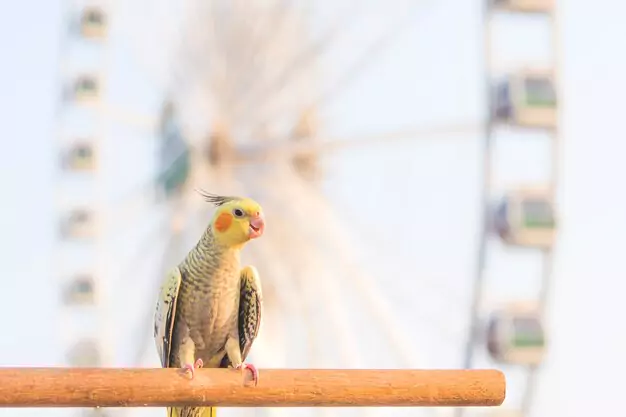
If you’re a cockatiel owner, you may have noticed a small colored ring around your bird’s leg. This is called a leg band, and it serves as an identification tool for breeders and organizations. But did you know that these bands can also provide information about your bird’s age?
What are Leg Bands?
Leg bands are small rings made of plastic or metal that are placed around a bird’s leg, including baby cockatiels, pet cockatiels, young cockatiels, and old cockatiels. They come in different colors, sizes, and shapes depending on the organization or breeder using them. Some bands may have letters or numbers engraved on them to indicate specific information about the bird.
How Can Leg Bands Indicate Age?
Different colors or markings on leg bands can indicate different years of birth for cockatiels according to the age chart. For example, some breeders use a system where each year has its unique color code, which can help you determine the age of your bird. If your bird has a red band, it could mean that it was born in 2019, while a blue band could mean it was born in 2020.
It’s important to note that not all breeders use the same color code system, so it’s best to ask the breeder or organization directly about what their leg band colors represent. If you’re getting a baby cockatiel or a pet cockatiel, it’s important to know the leg band color coding to track their age. Even if you have an old cockatiel, you can still use the bird age calculator by checking the color of their leg band.
Other Information Provided by Leg Bands
In addition to indicating age, leg bands can also help identify a baby cockatiel’s breeder or organization. For old cockatiels, the leg band can provide information about their medical history. If you have a pet cockatiel, the leg band may include letters or numbers that can help you track down their lineage.
However, it’s important to keep in mind that not all cockatiels have leg bands. Some may have had them removed due to injury or discomfort, while others may have lost them over time. If you’re unsure of your bird’s age, you can use a bird age calculator or consult an age chart.
Limitations of Using Leg Bands for Age Identification
While leg bands can provide some information about a cockatiel’s age and background, they should not be relied upon as the sole method of identification. For example, if you adopted a cockatiel that already had a leg band, there’s no way to know for sure if the band accurately reflects the bird’s age.
Some breeders may reuse leg bands from year to year or use different color codes than other organizations, which can lead to confusion and inaccurate age estimates for both old and baby cockatiels. This is important to keep in mind when purchasing a pet cockatiel.
Consulting with a Veterinarian
If you’re unsure about your cockatiel’s age or background, it’s always best to consult with a veterinarian. A vet can perform a physical exam and possibly even use imaging technology to get a more accurate estimate of your bird’s age.
They can also provide valuable information on proper care and nutrition for your cockatiel based on its specific needs and health history. Additionally, you can use a bird age calculator or age chart to determine your cockatiel’s age and better understand its life stage.
Physical Signs and Behavior Observation for Age Determination
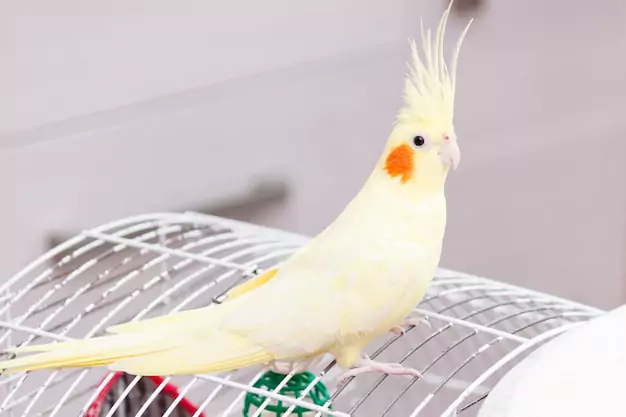
Cockatiels are a popular species of parrots that are known for their playful and affectionate nature. They have a lifespan of around 15 to 20 years, and their physical appearance and activities may change over time. As such, it is essential to observe the bird’s physical signs and behavior to determine its age accurately.
Physical Signs and Characteristics
Physical signs such as the baby cockatiel’s plumage, beak, and eyes can help determine its age. Younger birds tend to have more vibrant colors on their feathers than older ones. Their beaks are also smoother and less curved than those of older birds. The eyes of baby cockatiels appear larger compared to those of mature ones.
Observing the bird’s physical development at different ages can also provide clues to its exact age and maturity level. For example, young cockatiels have a soft downy covering on their head when they hatch from the egg. The covering will start disappearing after ten days, revealing feathers underneath.
Changes in Appearance
As cockatiels age, they may exhibit signs of dull appearance, reduced interaction with humans, and changes in their faces or activities. Older birds tend to lose some color in their feathers due to wear and tear from preening or exposure to sunlight.
As cockatiels mature into adults (between six months to one year), males develop brighter yellow heads while females retain their grey coloring throughout life. If you want to determine the age of your cockatiel, you can use a bird age calculator or age chart.
Behavioral Observations
Observing behavioral changes can also provide insights into determining the age of a cockatiel. Younger birds tend to be more active than older ones who prefer spending most of their time sleeping or resting quietly.
Moreover, baby cockatiels, which can be identified through a cockatiel age chart, often require more attention from humans than mature ones who have already established independence. They tend to show more curiosity towards new objects or toys placed near them compared to older birds who may ignore them altogether.
Energy Levels as an Indicator of Cockatiel Age
Observing your cockatiel’s energy levels can be a good way to determine their age. Younger cockatiels tend to have higher energy levels than older ones, and as they age, they may become less active and spend more time resting.
However, it’s important to keep in mind that changes in energy levels can also be influenced by other factors such as diet, health, and environment. For example, if your cockatiel is not getting enough exercise or is eating an unhealthy diet, this could affect their energy levels regardless of their age.
That being said, when it comes to your baby cockatiel, there are some general trends you can look for. Here is a cockatiel age chart to keep in mind:
Younger Cockatiels
Younger cockatiels are typically very energetic and active. They may fly around their cage or play with toys for hours on end without taking a break. They may also be more vocal and enjoy interacting with their owners.
If you have a young cockatiel that seems particularly high-energy, this could be a sign that they are still quite young according to the age chart. As they get older and move up the age chart, you may notice them slowing down a bit and becoming less interested in playing or exploring.
Adult Cockatiels
Adult cockatiels (usually between 1-5 years old) tend to have more moderate energy levels. They will still enjoy playing with toys and interacting with their owners but may not exhibit the same level of frenetic activity as younger birds.
As your cockatiel ages into adulthood, you may notice them spending more time resting or napping during the day. This is perfectly normal and nothing to worry about – just like humans, birds need plenty of rest to stay healthy!
Senior Cockatiels
Senior cockatiels (over 5 years old) will typically have lower energy levels than younger birds. They may spend more time resting and sleeping during the day and may not be as interested in playing or interacting with their owners.
If you have a senior cockatiel, it’s important to pay close attention to their behavior and energy levels. Older birds can be more susceptible to health problems, so any changes in behavior or activity level should be noted and discussed with your veterinarian.
Courting Behavior as an Indicator of Adult Cockatiel Age
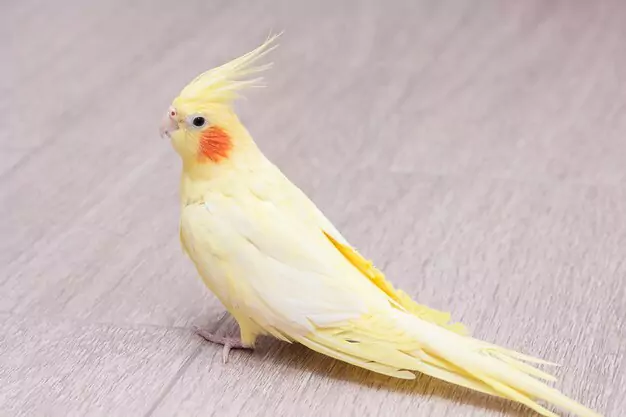
If you are a cockatiel owner, it is essential to know the age of your bird. The age of your bird can affect its care and behavior. One way to determine the age of your cockatiel is by observing its courting behavior. Courting behavior is a reliable indicator of adult cockatiel age.
Young Cockatiels do not Exhibit Courting Behavior until they Reach Sexual Maturity
Young cockatiels do not exhibit courting behavior until they reach sexual maturity. This usually occurs when they are around 12-18 months old. Before this time, young birds will not show any interest in breeding or mating.
Adult Male Cockatiels Display Courting Behavior by Whistling, Singing, and Dancing to Attract a Female Mate
Adult male cockatiels display courting behavior by whistling, singing, and dancing to attract a female mate. They will also bob their heads up and down while making soft chirping sounds. This courtship dance is intended to impress the female and convince her that he would be a suitable mate.
Adult Female Cockatiels Show Interest in Breeding by Soliciting the Male’s Attention and Inspecting Potential Nesting Sites
Adult female cockatiels show interest in breeding by soliciting the male’s attention and inspecting potential nesting sites. They will often follow the male around and make soft chirping sounds to get his attention. If she likes what she sees, she may start building a nest or laying eggs.
Adult Birds have Fully Developed Beaks, Tail Feathers, Flight Feathers, and Pin Feathers which are Absent in Young Birds that are Still Growing
Another way to determine if your bird is an adult or juvenile is by looking at its physical features. Adult birds have fully developed beaks, tail feathers, flight feathers, and pin feathers, which are absent in young birds that are still growing. Adult males also have a bright yellow face and crest, while females have a duller gray face and crest. If you’re unsure of your bird’s age, you can refer to a cockatiel age chart to help you identify whether it’s a baby cockatiel or an adult.
Bird Years to Human Years: How to Determine a Cockatiel’s Age

Cockatiels are lovely birds that make great pets. They have a lifespan of around 15-20 years in captivity, but determining their age can be difficult without proper documentation. In this article, we will discuss how you can determine your cockatiel’s age and estimate it in human years.
Using a Bird Age Calculator
A bird age calculator is an excellent tool that can help estimate your cockatiel’s age in human years based on their species and average lifespan. To use this calculator, you need to know the type of bird you have, its current age, and its expected lifespan. Once you input these details into the calculator, it will give you an estimated age in human years.
Sexual Maturity
Cockatiels reach sexual maturity at around 6-12 months old. This can be a helpful indicator of their age if they are breeding or showing other signs of adulthood. However, keep in mind that some birds may mature earlier or later than others.
Physical Characteristics
Physical characteristics such as feather condition, eye color, and beak shape can also provide clues to a cockatiel’s age. Younger birds tend to have brighter feathers and eyes while older ones may show signs of wear and tear on their feathers and discoloration in their eyes. Younger birds may have smoother beaks compared to older ones that may show signs of wear.
It is important to note that physical characteristics should only be used as supplementary methods for determining a cockatiel’s age since they are not always accurate indicators.
Other Factors
Other factors such as diet and environment can also affect a cockatiel’s aging process. A well-fed bird with access to plenty of sunlight and exercise is likely to live longer than one kept in poor conditions.
Cockatiel Life Stages: What Are They Like?
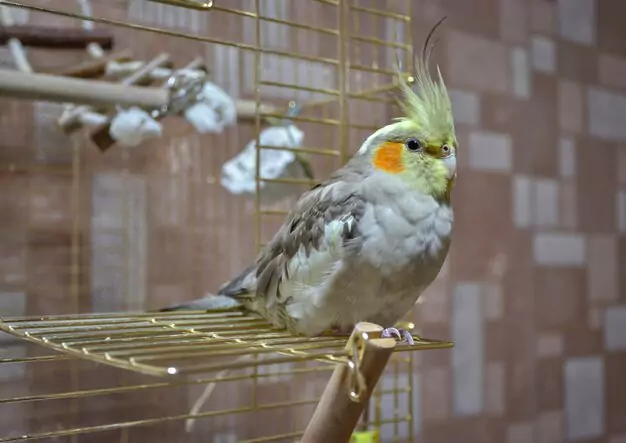
Cockatiels are a popular pet bird species that go through different life stages, just like other parrot species. Understanding the different life stages of your pet cockatiel can help you provide the appropriate care and attention they need to thrive. In this article, we’ll discuss the four main life stages of cockatiels and what you can expect from each stage.
Hatchling Stage
The hatchling stage is the first stage in a cockatiel’s life cycle. During this stage, baby cockatiels are born blind and naked, relying on their parents for warmth and food. The hatchling stage lasts for about three weeks until they start growing feathers. At this point, they become more active and alert.
As a pet owner, it’s important to provide a warm and comfortable environment for your baby cockatiel during this stage. You should also ensure that they receive proper nutrition from their parents or hand-feeding formula if needed.
Juvenile Stage
The juvenile stage is when your cockatiel starts to grow feathers and develop its personality. This stage typically lasts from 4-6 weeks until around 6 months old. During this time, your bird will become more independent from its parents as it learns to fly, perch, and explore its surroundings.
As a pet owner, you should provide plenty of toys and perches for your juvenile cockatiel to play with as it develops its coordination skills. You should also continue offering nutritious foods such as pellets, fresh fruits, vegetables, and seeds.
Adult Stage
The adult stage begins at around 6 months old when your bird reaches sexual maturity. Female cockatiels tend to mature faster than males, reaching sexual maturity at around 9-12 months old. During this stage, your bird will have fully developed feathers and colors that distinguish them from juveniles.
As a pet owner, you should continue providing a healthy diet and plenty of mental stimulation for your adult cockatiel. This can include toys, puzzles, and social interaction with other birds or humans.
Senior Stage
The senior stage is the final stage in a cockatiel’s life cycle. This stage typically begins at around 10-12 years old and lasts until the end of their lifespan, which can be up to 20 years or more. During this stage, your bird may start to show signs of aging such as decreased activity levels and changes in behavior.
As a pet owner, it’s important to provide extra care and attention for your senior cockatiel. This can include offering softer foods that are easier to digest, providing comfortable perches and bedding materials, and scheduling regular check-ups with an avian veterinarian.
Baby Cockatiel Growth Chart: Monthly Milestones and Daily Development
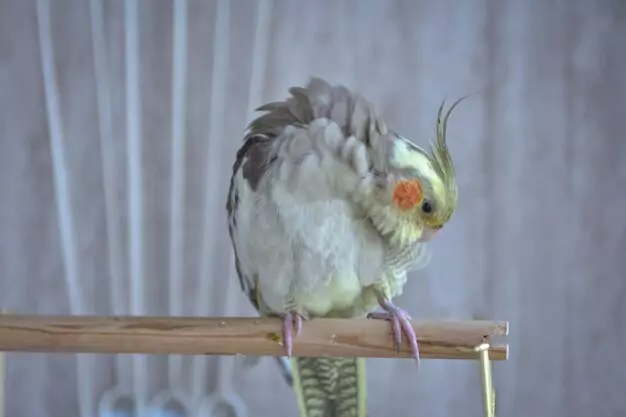
If you’re a proud owner of a baby cockatiel, it’s important to keep track of its growth milestones using a growth chart. This will help ensure that your pet is developing properly and receiving the best possible care. In this article, we’ll discuss the monthly milestones and daily development of baby cockatiels.
First Month
During the first month of their life, baby cockatiels grow rapidly, gaining around 10% of their body weight each day. They are born with closed eyes and no feathers, relying on their parents for warmth and food. By the end of the first week, they will have doubled in size and developed small pinfeathers.
At two weeks old, young cockatiels will start to develop their wing feathers and be able to stand up on their own. By three weeks old, they will have opened their eyes completely and grown more feathers. They will also start to explore their surroundings more actively.
Second Month
By the end of the second month, young cockatiels should have developed their crest – a signature feature of adult cockatiels – and be able to perch on their own. They will also start to chirp more frequently as they learn how to communicate with others.
Third Month
At three months old, baby cockatiels experience their first molt as they shed their downy feathers for adult ones. During this time, they may become more irritable or lethargic than usual due to hormonal changes in their bodies.
Fourth and Fifth Months
During the fourth and fifth months, baby cockatiels continue to develop their flight feathers and learn how to fly according to the cockatiel age chart. This is an exciting time for both you and your pet as they gain more independence while still requiring your guidance.
Sixth Month
By six months old, a baby cockatiel’s beak will have reached its full size, and they will have developed their signature cheek patches. They will also be fully feathered and able to fly with ease. At this point, your pet is considered an adult and should be fed a diet appropriate for adult cockatiels.
Understanding Your Cockatiel’s Age with the Age Chart
Determining the age of your cockatiel is crucial to provide proper care and attention. The age chart is a useful tool that can help you identify the age of your feathered friend accurately. In this article, we have explored various methods to determine the age of a cockatiel, including age tracking, behavioral aspects, leg bands, physical signs, energy levels, courting behavior, and bird years.
By observing your cockatiel’s behavior and physical features such as feathers and eyes, you can get an idea about its approximate age. Leg bands are also used for identification purposes. However, it is essential to understand that they may not always be accurate.
Energy levels are another indicator of your cockatiel’s age. Younger birds tend to be more active than older ones. Courting behavior can also indicate adult age in cockatiels.
Furthermore, understanding bird years and their conversion to human years can help you determine the exact age of your feathered friend, whether it’s a baby cockatiel or an adult bird.
Cockatiels go through different life stages from babyhood to adulthood. Each stage has unique characteristics that require specific care and attention.
If you have a baby cockatiel or planning to adopt one soon, monitoring its growth using a growth chart is vital. It will help you track its monthly milestones and daily development accurately.
In conclusion, understanding your cockatiel’s age with the age chart is essential for providing proper care and attention. By exploring various methods discussed in this article such as behavioral aspects, leg bands identification, physical signs observation energy levels indication & courting behavior analysis; you can get an estimate of how old your bird might be!








